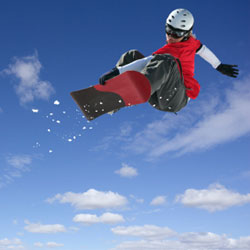Outdoor winter activities

Ice skating, skiing, snowboarding, snowmobiling and tobogganing are fun activities for a nice winter day. However, parents and children need to be aware of possible dangers associated with these winter activities.
The Emergency Department of The Montreal Children’s Hospital sees an average of 500 injuries per year related to these winter activities. Some of the common injuries include: traumatic brain injuries, assorted limb fractures, abdominal and pelvic injuries, as well as dental injuries.
Skating
- Make sure that the skates fit properly and support the foot and ankle.
- Make sure blades are sharpened.
- Wear an approved protective helmet recommended for hockey. Consider using knee, wrist and elbow pads.
- Skate only on areas specified for the activity and check the ice condition before skating.
- Young children and novice skaters require adult supervision.
Skiing and snowboarding
- Check that the equipment is the appropriate size, fits properly and meets safety standards.
- Wear a ski or snowboarding helmet and protective goggles. Consider wearing elbow and knee pads for snowboarding. For more details on how to choose a helmet, visit: http://www.moncasque.ca/choisir.html
- Ski or snowboard only in an area identified for the activity.
- Avoid slopes that are beyond your skill level.
- Make sure that children receive proper instruction on how to use equipment before attempting this activity.
- Check the condition of the hill. Icy surfaces are dangerous. Click here for details about weather and surface condition of hills across Quebec.
- Be aware of other skiers or snowboarders on the hill to avoid collisions.
Tobogganing
- Supervise young children.
- Use traditional sleds and toboggans, which allow for better control.
- Avoid hills that exceed a child’s skill level. Ensure that younger children toboggan on hills with a gentle slope.
- Use areas designated for this activity.
- Always check the conditions of the hill; avoid icy conditions.
- Make sure there are no obstacles along the path of the hill, such as park benches, trees, bicycle racks, frozen bails of hay, wooden boards, and metal fences.
- Make sure the bottom of the run has enough flat space so the toboggan will come to a stop by itself.
- Do not pile too many children on a toboggan. Follow the manufacturer’s recommendations.
Teach children to:
- Wear a helmet (ski, bicycle or hockey type).
- Avoid wearing scarves. Use neck warmers instead.
- Always sit facing forward; never stand.
- If you lose control, roll off sideways and do not try to stop the toboggan or sled using hands or feet.
- Quickly move off the slope (get out of the way at the bottom of the hill) when you have reached the bottom to avoid being hit by oncoming sliders.
- Toboggan during daylight.
- Never slide towards the street.
Snowmobiling
- Stick to the speed limits indicated on the marked trails
- Sledding and drinking don't mix
- Stick to the right at all times
- Stop at all road crossing
- Sustain a reasonable distance with the sledders ahead of you
Related articles
- Le port du casque en hausse au Québec (in French only)
- Pas de casque obligatoire pour le moment (In French only): Radio Canada, October 2009
Reviewed by Trauma specialists at the Montreal Children’s Hospital.
Last updated: July 2013, January 2016


